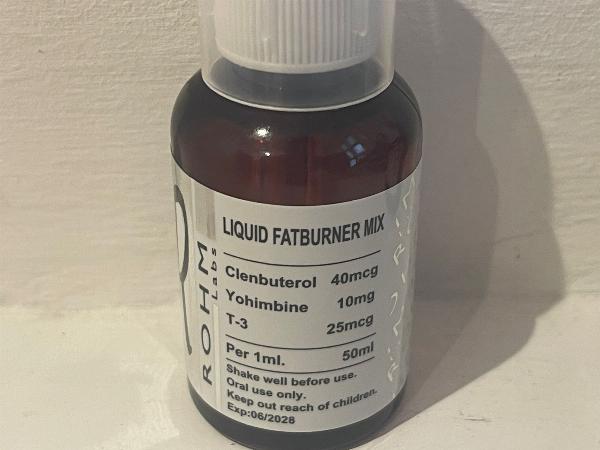The complete guide to social media campaigns [+ 4 examples for 2024]
Creating a social media campaign is an intricate process that requires deeply understanding your audience, brand, products and competitors. From start to finish, it’s imperative to stay focused on your brand’s goals and your audience’s needs.
And the campaign doesn’t end when your team hits “publish.” Tracking, monitoring, listening and analyzing campaign results is crucial to refining your social media marketing strategy and proving the far-reaching impacts your team has on company goals.
In this guide, we’re sharing the essential steps to running a social media campaign, planning, four (and a few bonus) of our favorite recent campaigns and 20 tips for building your own unforgettable campaign.
Skip ahead with these links:
What is a social media campaign?How to plan the best social media campaignsHow to run a successful social media campaign4 creative social media campaign examples to inspire you in 2024How to create KPIs and benchmarks for a social media campaign20 factors the most successful social media campaigns have in commonBefore you dive in, download our social media campaign brief template to start your campaign efforts strong.
Download the template
What is a social media campaign?
A social media campaign is a coordinated set of marketing actions across one or many social channels. The tactics share a common purpose and are designed to reach your company’s goals.
They’re usually part of an omnichannel strategy. Components of a social media campaign include:
Organic postsPaid promotionsContests and giveawaysBranded hashtagsUser-generated contentCreator and influencer partnershipsAccurate reporting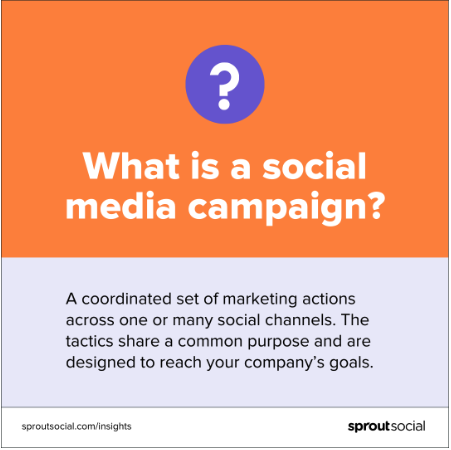
How to plan the best social media campaigns
Before you can get creative with your campaign, you need to do your research. And this starts by putting an ear to the digital ground and listening—to both your audience and competitors alike.
To design the strongest campaigns possible, start by listening to what your audience is saying on social. Using an AI-powered social listening tool like Sprout to analyze conversations across all social networks enables you to do three crucial things to build your campaign:
1. Understand your target audience
When you don’t begin by listening to your audiences and build campaigns around what they actually care about, you might end up pushing out content that just isn’t quite right.
Social listening enables you to analyze your target audiences’ conversations about your brand, product, competitors and existing campaigns. And that makes it possible to extract the topics that matter to your target audience and develop campaigns and messaging that resonate.
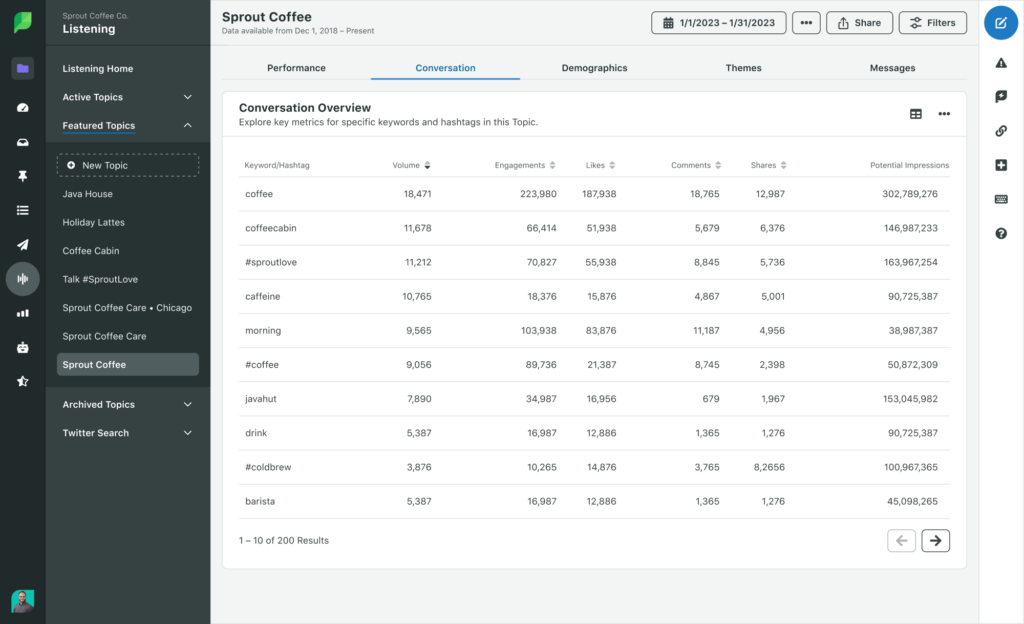
2. Do a competitive analysis to set yourself apart
A competitive analysis can also help you understand where you fall among your competitors—where they fall short and where you outpace them. Knowing your competitive position can help you set goals for your campaign. For example, using social listening during a competitive analysis can help you understand metrics like share of voice. You can understand how you stand out from the competition and how you need to tailor your campaign to improve your SOV.
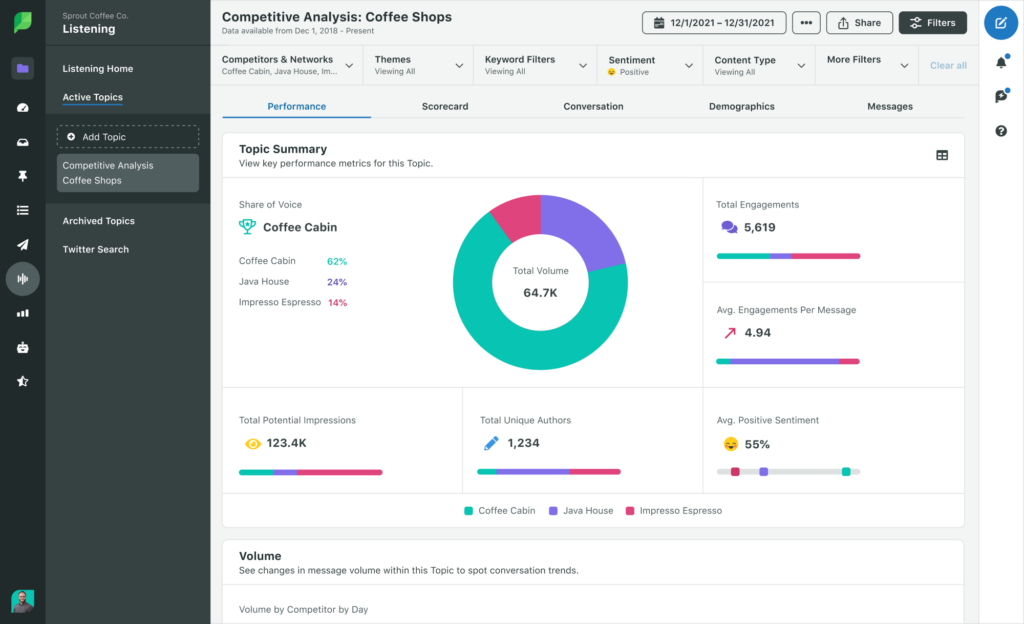
3. Analyze campaign performance
AI-powered social listening tools enable you to go beyond measuring performance metrics to actually understand how audiences feel about your campaigns.
Understanding how past campaigns were received is helpful when crafting new ones. But it can also be helpful in the moment if you need to adjust a campaign that isn’t getting the right reception.
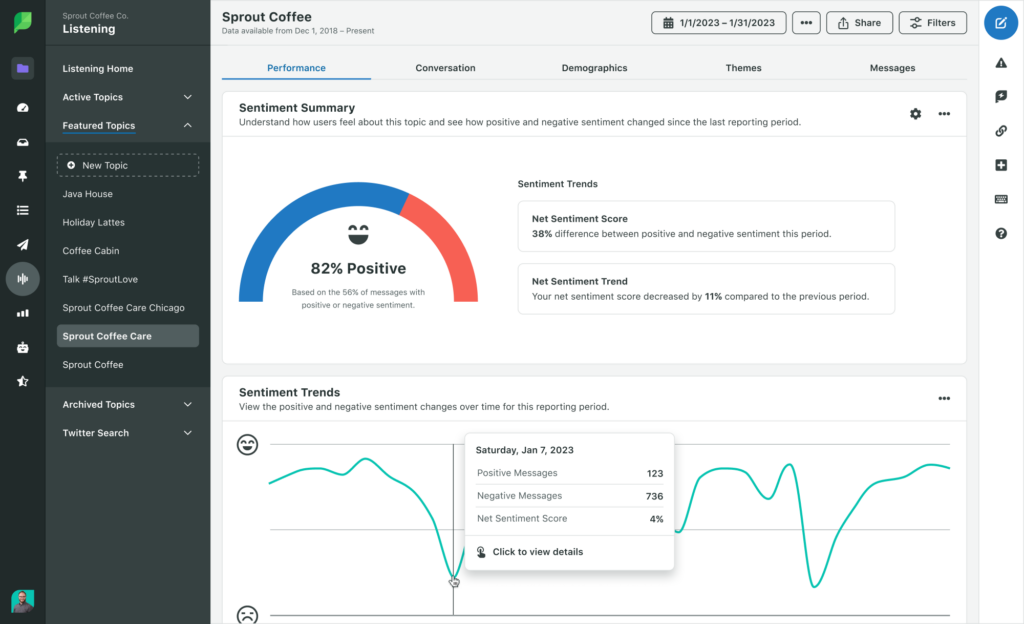
How to run a successful social media campaign
To run your high impact social media campaign from start to finish, use this three-step process.
1. Brainstorm social campaign themes
Generate social media campaign ideas by asking your team (and teams outside of social) these questions:
What are your target audience’s challenges?How does your brand help overcome them?What do we want to accomplish with a social media campaign?During the ideation stage of your social media campaign, it’s imperative to consult with teams from other business functions to ensure you have a complete understanding of your customers, your products and your competitive landscape. The insights you glean from other teams can inform and bolster a campaign to make it even more audience-driven. In fact, The Sprout Social Index™ revealed that 65% of marketers agree other departments inform their social efforts.
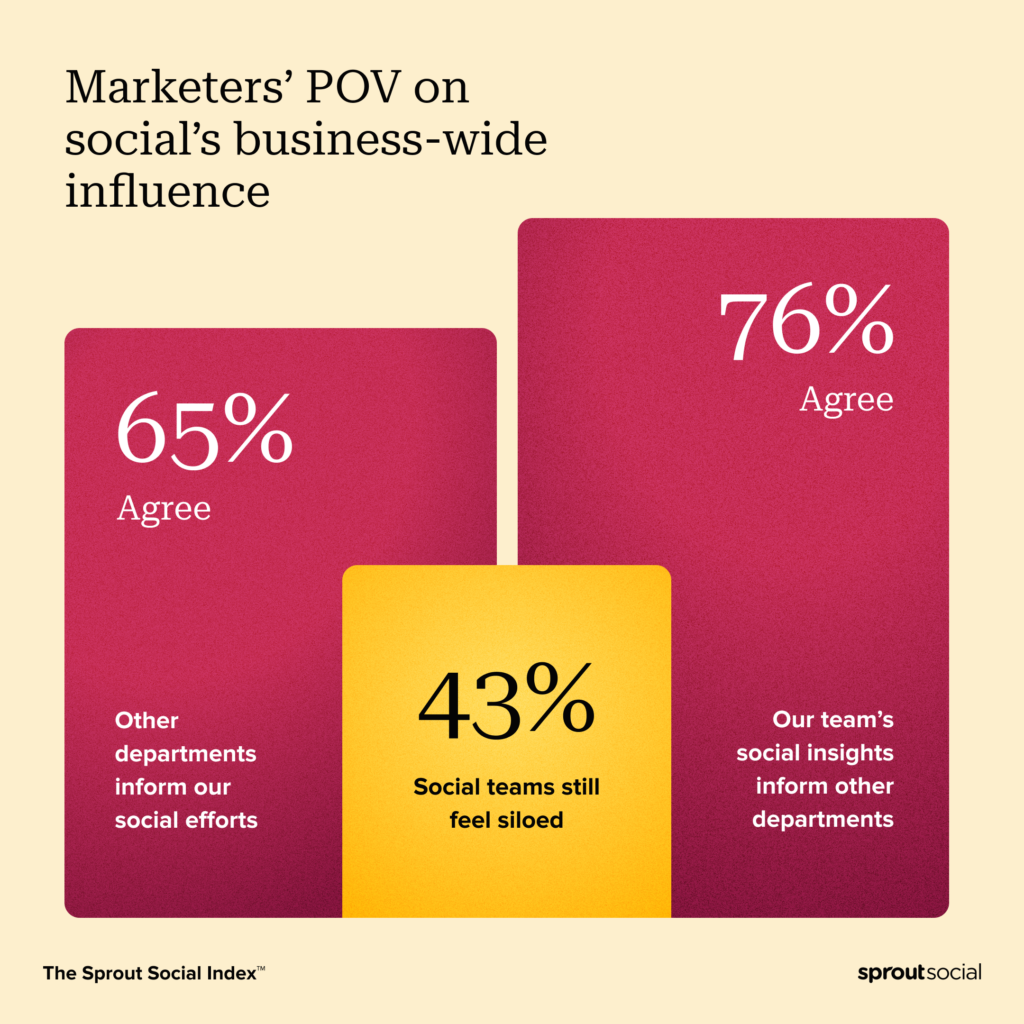
2. Build out your creative and content
Once you ground yourself in the “why” behind your campaign, it’s time to build out the content. Here are some sources of creative inspiration that will help make your next social campaign truly memorable.
Partner with influencers and creators
Influencers and creators are already masters of creating content that resonates. They’ve built their followings based on engaging content they share on social. With their expertise, they can produce unique content for your brand that strikes a chord with their community.
Most importantly, influencers bring a key element to your campaign: authenticity. Which, according to the Index, is the number one thing consumers don’t see enough of from brands on social.
Align with the customer journey
Not every piece of content you produce needs to align with all members of your target audience across the sales funnel. Instead, shift your focus to create content specific to where your campaign audience is in their buying journey.
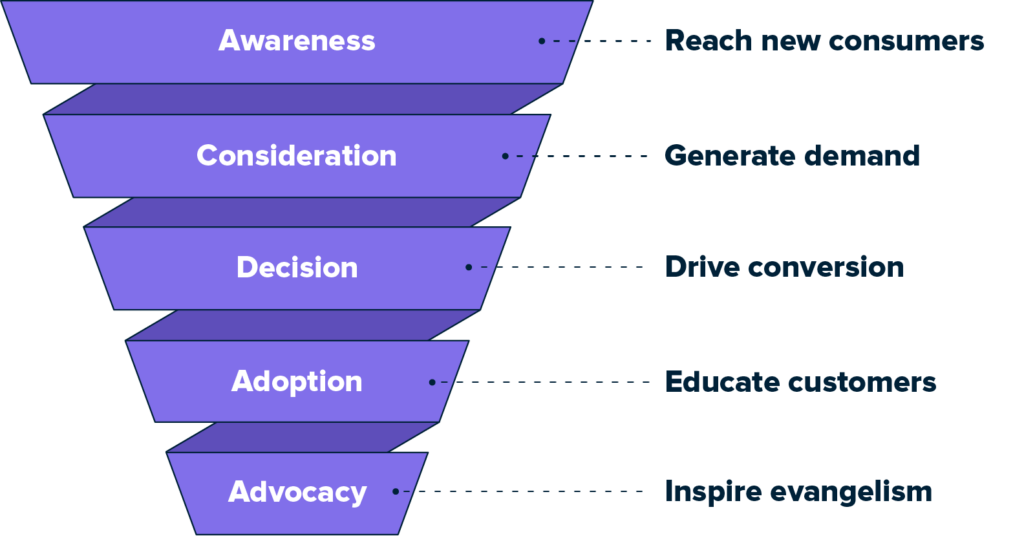
For example, in the awareness stage, your goal is to increase the number of people who know about your brand, services and offerings. The content you produce within this stage needs to be eye-catching, but doesn’t necessarily have to speak directly to what your brand has to offer. The focus here is to grab your audience’s attention. “Edutainment” content—social posts that entertain and educate—is perfect for this journey stage. Think infographics and how-to videos.
Share user-generated content
The most memorable brands on social have the best products and services, according to the Index.
By reposting user-generated content (UGC), you fulfill your audience’s expectations while saving your team time and creative resources. And your brand advocates are delighted to be featured by your brand and have a chance to grow their following. So, tapping into UGC is a win-win-win.
Post content formats your audience wants to engage with
Short-form video has been king for a while, and that remains true. The Q4 2023 Sprout Pulse Survey found that 81% of consumers want marketers to focus on short-form content production.
But remember that your audience’s preferences might differ slightly from the general population, so it’s important to factor in your most successful content types and themes using your organization’s own benchmark or historical data.
Size up the competition
If you’re running out of content ideas to fuel your social campaigns, turn to your competitors for inspiration. Your brand and your competitors may be targeting similar ideal customer personas, so zero-in on where their social efforts are winning share of voice. What are they doing that works? Where are they missing the mark?
Be careful not to mimic your competitors’ content, but instead use their social strategies as a catalyst for your creative ideas.
3. Choose your metrics and measure success
Choosing the right social media metrics to track and analyze is vital to properly gauge the success of your social media campaigns, and how well your campaign translates to reaching business goals. With the tremendous amount of social data now available, be sure to choose metrics that align with your objectives. For a complete deep-dive, check out this video that walks you through the 17 most important social media metrics.
When it comes to tracking campaigns, engagement metrics—such as the number of unique people who have clicked, liked, commented on or shared your posts—typically provide the most compelling data to determine your campaign’s overall effectiveness.
Once you determine the metrics that matter most to your campaign, start measuring your success and reporting on your social media analytics. Measuring performance throughout your campaign enables you to make adjustments to your social media strategy and content using real-time audience insights.
4. Use technology to manage your campaign from start to finish
To keep your campaign organized—from ideation to content creation to making sense of your metrics—use a social media management platform like Sprout. With Sprout’s Campaign Planner features, create everything you need to run a successful campaign in one place, including briefs, creative assets and analytics reports.
Start your free Sprout trial
4 creative social media campaign examples to inspire you in 2024
Some of the best social media campaigns have joined the ranks of the greatest creative efforts in advertising history.
To help you get inspired, here are some attention-grabbing creative social media campaign examples to get your creative gears turning.
1. LEGO’s Botanicals Challenge
LEGO never fails to create fun content. And recently, they leaned into their slogan “adults welcome” with a social campaign built to bring attention to new additions in their Botanicals Collection—a range of flower-building sets.
LEGO chose the perfect time to promote these new flowery sets—in the lead-up to Valentine’s Day. Their social campaign consisted of a few pieces (no pun intended). On TikTok, they featured a weekly LEGO Botanicals Challenge where florist creators were challenged to make creative displays using Botanicals sets.
@legoBryce is bringing the outside in this week on the LEGO Botanicals Challenge. Watch the whole thing: @FLOWER BOY #flowertok #flowersareforever #legobotanical #lego
♬ original sound ' LEGO








